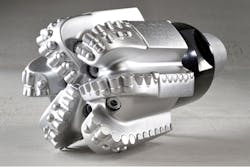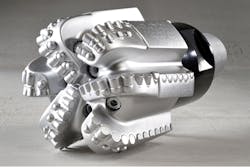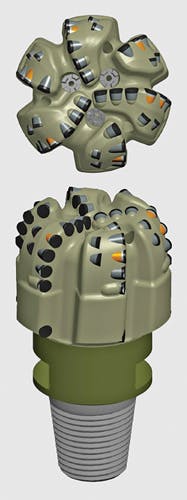Manufacturers describe technology improvements that decrease drilling costs
Dick Ghiselin
Contributing Editor
Perhaps the most fundamental tool of well drilling is the drill bit. With a sesquicentennial history, it would be easy to take bits for granted. After all, they are required for every drilling operation. In short, they represent a quite mature technology.Offshore asked bit manufacturers to describe their latest advances in design, materials, and performance. Their responses are eye-opening, and quite in keeping with the industry's present cost-cutting initiatives. Today's drill bits are not cheap, nor are they expected to be; but the efficiency and performance quality of today's technology transcends bit costs - their value far exceeds their price. Technology advantages are presented in the order received.
Halliburton
Recognizing that no two wells are alike, Halliburton has developed a family of completely customizable GeoTech Fixed Cutter polycrystalline diamond compact (PDC) drill bits with the objective of optimizing bit performance for the section to be drilled and the bottomhole assembly to be used. Using a design at the customer interface (DatCI) optimization process, the company's localized technology teams can create 3D bit designs using the latest dynamics modeling. Four powerful computerized design tools are combined within the DatCI process:
• iBiTs a patented system for creating 3D bit designs, including upgrades that closely simulate optimal cutting structures for specific applications.
• Enhanced hydraulics modeling to minimize erosion and provide ample junk slots for cuttings removal.
• SPARTA drilling optimization software with an advanced rock mechanics module to link bit design to formation properties.
• A DrillingXpert simulator that enables designers to quantify the implications of design options and recommend the best combination for the task at hand.
Among the options available in the design program are an application platform, blade count, cutter size, backup cutter types, and a thorough list of optional features. Among the parameters addressed are vibration, longevity, rate of penetration (ROP), and hole quality. Each option selected can be simulated to tell the designer the effect of choices made for the specific application for which the bit is being designed.
As a result, each GeoTech bit design features rock-interaction analysis, depth of cut control, cutter technology for increased longevity and ROP, improved hydraulics, and advanced materials usage. Benefits include reduced axial, lateral and torsional vibration, smoothed-out torque variations, and back-up cutters to reduce wear. According to the company, field experience with the new bits shows a higher amount of rock removed with less wear, along with higher ROP and as much as four times the footage of previous products. Hydraulics design objectives include minimized recirculation flow and elimination of stagnant zones to optimize bit cleaning and cuttings transport and minimum erosion. The use of advanced materials benefit bit body toughness and enable innovative steel-blade geometries to be used to provide aggressive matrix body design.
Schlumberger
Smith Bits, a Schlumberger company, focuses on extending bit longevity with optimal performance to provide bits that are capable of drilling entire well sections with a single trip. By reducing or eliminating trips to change worn or poorly performing bits, the company makes a step-change reduction in nonproductive time with cost savings for its customers.
Two recent designs exemplify the high-performance drill bits. StingBlade bits introduce new conical diamond element cutters with a much higher diamond content to increase ROP while extending bit life.
On a recent well in Australia's offshore Browse basin, a 12¼-in. StingBlade bit increased ROP by 57% while boosting footage drilled by 97%, saving five days of rig time. The new bits were welcomed by the operator who had experienced excessive wear drilling through the basin's alternating limestone and chert formations with very high compressive strengths.
The Onyx-360 rotating cutter drill bits feature strategically-placed continually rotating cutters that present a new sharp face to the rock with each rotation. Bit design software calls for a few rotating cutters placed in high-wear locations on the blades, the rest of the cutters are conventional, fixed cutters.
On a well in Australia's North Bonaparte basin of the Timor Sea, previous wells encountered a highly abrasive sandstone layer. Drilling was characterized by very low ROP and extremely high bit wear. On the next well, the Onxy-360 bit was run with a 319% improvement in ROP and the entire abrasive section was drilled in a single trip as opposed to four bit-trips for the offset well. Torque response was smooth compared to the highly-erratic performance on the previous well.
Increased bit longevity and ROP saved the operator more than $1 million.
During 250 bit runs in 14 different countries, StingBlade bits averaged 55% increase in footage drilled with a 30% increase in ROP compared with offsets. In South Texas horizontal wells, 23% higher build rates were experienced. Elsewhere, lateral and axial vibrations were reduced 53% and 37%, respectively. Geoscientists hail the StingBlade bit's ability to generate much larger cuttings that are easier to analyze.
There are many benefits of these new, high-performance bits. Principle among these is increased longevity and high ROP that save considerable rig time every time they are deployed. This goes straight to the operator's bottom-line.
Varel International
The IMax impregnated drill bit series from Varel International promises high performance in hard and abrasive formations. The new bits are based on the latest design, material, and manufacturing science and are optimized to drill faster and last longer in challenging applications.
Key features of the series include:
• Strict diamond selection of similar size and quality
• New pelletization process ensures uniform diamond distribution in each cutter
• Improved diamond/matrix bonding
• Infiltration in a controlled environment to reduce oxidation and graphitization
• Cylindrical hot isostatic pressed segments tailored to the formation
• Custom cutting structure design using proprietary SPOT bit design program.
In addition to PDC-like cutters, IMax bits feature a diamond-impregnated matrix in the cone, nose, shoulder, and gauge areas of the bits to enhance bit life. Computational fluid dynamics software is used to model and optimize bit hydraulics. Total flow area can be varied depending on the application and can be fine-tuned by changing nozzles on site.
Like a modern dentist's drill, IMax drill bits are designed for high RPM and low weight-on-bit. This delivers high ROP in hard formations while minimizing vibration. Typically mud turbines are used in conjunction with the bits to generate RPMs as high as 1,600 for maximum drilling efficiency.
Premium Vulcan cutters provide a hybrid design for IMax bits with a dual cutting structure. The benefit is maximized when drilling transition zones.
IMax bits are differentiated from other bits because of their diamond-impregnated matrixes that grind away on hard formations. As the matrix wears it exposes new diamonds, refreshing the cutting structure until the bit run is complete. PDC cutters are used only in the center of the bit to prevent coring and in the gauge area to prevent under-gauge drilling. Thus, rock is destroyed by a combination of shearing, grinding, and plowing. In addition, the manufacturing process is different than that used by others.
The process imposes minimal thermo-mechanical damage to the natural diamonds, leading to improved efficiency and durability, for longer life and improved ROP.•







